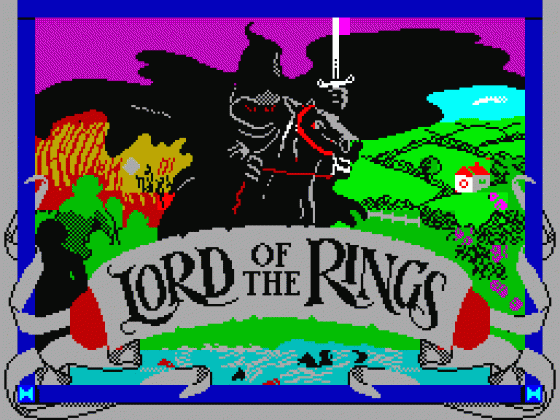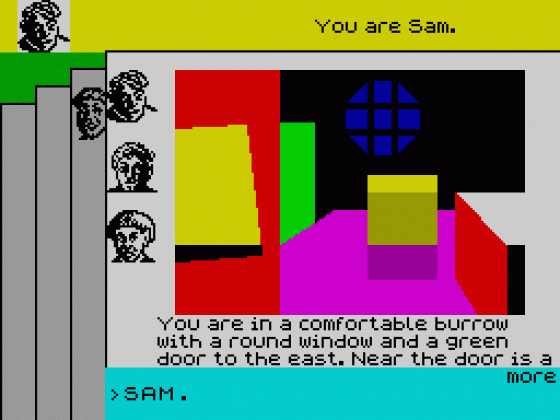
Crash
 1st March 1986
1st March 1986
Categories: Review: Software
Author: Derek Brewster
Publisher: Melbourne House
Machine: Spectrum 48K/128K
Published in Crash #26
Lord of The Rings
Ever since The Hobbit was released by Melbourne House, games players everywhere have eagerly awaited the computer version of JRR Tolkien's greatest work, The Lord of the Rings. The Hobbit computer game was widely regarded as one of the best programs to run on a Spectrum and even now it still stands as one of the best adventure games you can buy. Its lasting appeal can be attributed to its immense intricacy of plot and the high competency of its programming. Lord of the Rings, dealing with the story found in the first part of the trilogy, The Fellowship of the Ring, sacrifices some of the programming panache of The Hobbit in order to offer as wide an entertaining medium as is possible on a Spectrum. Pictures are relatively infrequent, and where they do pop up, are nothing to get excited about. The program is undeniably slow and the glaring white background to the text gives the impression that Philip Mitchell has been too busy with his own pet project to see the great lengths to which other software houses have gone to impress with their presentation.
You might now think that this review is about to concur with one or two others which have fallen short of praising this new adventure. Not so. Considering the enormous efforts made to make this game deep, intricate and entertaining, one can overlook the minor irritations in presentation, speed and debugging and applaud Melbourne House for a very courageous and worthwhile effort in bringing such a monstrous project to fruition. In short the game succeeds in doing what it set out to do, entertain, and I thoroughly enjoyed playing it.
Now that I've got that off my chest let's see what you gets for your money. As with The Hobbit, you get the corresponding Tolkien book, The Fellowship of the Ring, which is the first part of the Lord of the Rings trilogy. This Allen & Unwin paperback is more than just a sales ploy as it contains important background and clues to your quest. Furthermore, it contains maps of The Shire where you begin the adventure, and the whole of the western section of Middle Earth by which you can gauge the threat emanating from the east. An impressive booklet of very full instructions is also included, which serves both as an introduction to the game and as a broader intro to the whole world of adventuring. It is a most lucid and palatable guide and does a superb job of introducing quality adventuring to the novice. The game itself spans two cassettes. On each is a challenging adventure on the A side along with its beginner's counterpart on the B side. The beginner's games, like the booklet, are simply superb, introducing the concepts and challenges to be found in the games proper in a very informative manner.

The story behind the game will be very familiar to Tolkien fans but probably be pretty confusing to those who have never picked up on the books. It is the Middle Years of Middle Earth and Sauron the Great, master of the evil realm of Mordor, has tricked a great Elvensmith into teaching him the craft of making rings of power. Deep within the bowels of Mount Doom he forged a ring to rule all others. By a circuitous path the ring came into the possession of Gollum who fled with it to the Misty Mountains and the dark caves that ran beneath them. Bilbo Baggins, a Hobbit, found the ring in the goblin's den and kept a hold of it by outwitting the pathetic creature. Bilbo returned to The Shire with the ring, and for the last time, used the ring's curious ability to render the wearer invisible before handing it on to his heir, Frodo Baggins. The ring causes some strange side effects however, making its owner overjealous. Gandalf, a fatherly wizard, warned Frodo of the malevolent nature of the ring. Making too much use of the ring would see its owner fade into a ring-wraith. Bilbo retired to Rivendell to the east, and the ring was entrusted to Frodo, whose struggle to keep the ring safe from the servants of doom is told in the Lord of the Rings trilogy.
The adventure begins with Sam, Pippin and Frodo at Bag End, Frodo's home in Hobbiton. Merry awaits the party at his house in Crickhollow to the east, by the western bank of the Brandywine river. Now, if the computer game carried on just like the book there would be little point in playing the adventure. The Beam programming team have cleverly devised a plot which has enough in keeping with the Tolkien work to justify its name, but not so much as to make playing futile. There are new paths, new situations and novel twists which will ensure that a thorough knowledge of the books alone will not give an easy victory. At no point is knowledge of the books assumed, although thorough reading is recommended, if only to gain insight into the fantastic world of Middle Earth.
The first striking feature of the game pops up right at the start, when you are offered the option of playing up to four Hobbits during the one game. The characters of Frodo, Sam, Merry and Pippin are up for grabs, although the booklet warns that it may be easier to begin with just the one character. Indeed, the beginner's program settles for Frodo only. Even in the beginner's program there is still plenty of scope to influence the behaviour of your Hobbit companions via the use of the influential and highly effective SAY TO command. Often the likes of SAY TO character 'HELLO' is sufficient to draw most characters into conversation. As in most commands which are used often, the programming team have thoughtfully provided the abridged form of (GANDALF) 'HELLO' as an option.
Many of the problems you face will be impossible to unravel without the help of other characters, some of whom will only be helpful if you adopt the right tone or ask the right questions. Your fellow Hobbits will, as a rule, follow your lead and can be made to do most useful tasks as with SAY TO SAM 'CLIMB TREE'.
Playing the game you find the booklet isn't kidding about playability. Your active control of characters in combination with the computer's habit of intelligently keeping the action moving along when you are not controlling things is one of the perfectly enchanting aspects of the game. The program really does its level best to act intelligently at all times.
Going beyond the beginner's program you might like to play the game with friends, each on taking on the responsibility for one furry-footed Hobbit. The commands BECOME PIPPIN or I AM PIPPIN, or simply PIPPIN, will swing the game round so it is played out through the eyes of Pippin until it is changed once more. To show who is playing at any particular time, and to indicate which Hobbits are present with you, the screen uses a layered effect whereby the top layer has I AM FRODO etc along the top with his picture, while down the sides are the pictures of any other Hobbits present. Lower layers show the pictures of Hobbits not currently present in the same location. This use of layers slows the game down - with every new location the layers are re-sorted to reflect any splits or meetings in the groups.
When arranging parties to tackle specific problems it might be worth remembering that Pippin is the most agile, Sam the most sturdy, and Frodo the smartest. Sam, being Frodo's devoted friend, always tries to stay close to him. During the course of the game characters suffer weariness from the constant struggle and their strength declines. The best remedy for low morale is a good meal and a rest, but if the Hobbits should chance upon skilled healers or magical herbs this helps them endure the fray even better. In combat, Hobbits are generally thought poor fighters as they normally live cheerfully peaceful lives in the relative seclusion of The Shire - so they should not be thrown into the midst of gory battle.
Towards the end of the booklet an abbreviated vocabulary gives some insight into the 800 words used by the adventure. The rules which govern the use of Inglish (first used in The Hobbit) are related at length and are informative enough to guide even a newcomer to the delights of adventuring. The program is very good at asking for clarification of any input about which it is not sure.
Two features from The Hobbit have been retained in this game. Mapping in The Hobbit could become pretty unreliable owing to the structure of the game, and so it is in this case. The other feature of The Hobbit retained is the need to be ever careful and watchful over what and how many items you are carrying. In addition to adding weight to your burden, some objects increase your effective size, which can lead to trouble when negotiating a small door or tunnel. Liquids cannot be carried without a container and you must ration your acquisitions to just those you can manage to carry.
Lord of the Rings took over 15 months to program. After waiting for so long people may initially be disappointed with the result. The game is slow, the pictures are rudimentary, and, due to the glaring white background for the text, this adventure is almost unplayable on a colour TV. The prose is strangely stilted with descriptions which tell of objects within objects and upon objects, in a very dry and dreary manner. The dubious examples of humour in the game detract from such an auspicious work and there are times when you're not quite sure whether something is supposed to be humorous or not, like, were there really photographs in the original as found described in the first frame? Having said that, the game features a very good and informative EXAMINE command, a super friendly vocabulary which gets just about anything you want to do done, and it takes the interaction of characters to new heights in adventuring.
On the whole, despite unfavourable reviews from other quarters, this adventure is worthy of a Smash as it reveals enough features to place it above the usual release. In particular, its friendly vocabulary and its options on character play add to the standing of an already monumental work.
Comments
Difficulty: not difficult
Graphics: to be honest, poor
Input facility: well beyond verb/noun
Response: slow
Other Reviews Of Lord of The Rings For The Spectrum 48K/128K
Lord Of The Rings (Melbourne House)
A review by Grim Reaper (Your Sinclair)
Lord Of The Rings (Melbourne House)
A review by Richard Price (Sinclair User)












